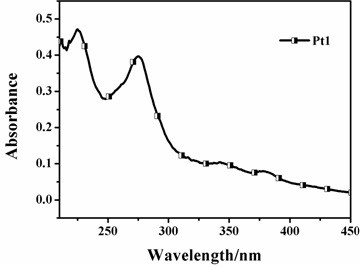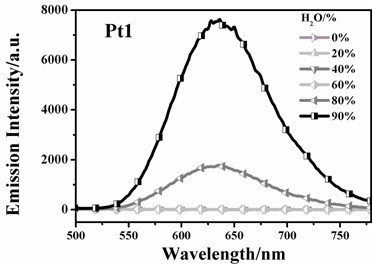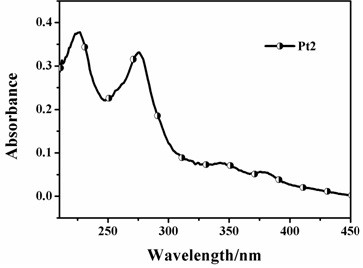Preparation method and application of a cyclometal platinum complex with aggregation-induced luminescent properties
A technology of aggregation-induced luminescence, platinum complexes, applied in platinum-based organic compounds, platinum-based organic compounds, luminescent materials, etc., to achieve environmentally friendly effects
- Summary
- Abstract
- Description
- Claims
- Application Information
AI Technical Summary
Problems solved by technology
Method used
Image
Examples
Embodiment 1
[0019] The synthesis of embodiment 1 compound Pt1
[0020] (1) Synthesis of cyclometal ligands:
[0021] Add 2-bromopyridine (1.0 mmol), 4-methylphenylboronic acid (1.5 mmol), potassium carbonate (2.0 mmol), palladium acetate (0.015 mmol) in turn to the reaction flask, and then add ethanol- Mix 8 mL of water solution with magnetic stirring at 80 °C for Suzuki reaction, follow the reaction process by thin-layer chromatography, after the reaction is complete, add 20 mL of saturated saline, extract the reaction product 3 times with 20 mL of dichloromethane, combine the organic phases, reduce Concentrated under reduced pressure and separated by column chromatography to obtain a C^N-type cyclometal ligand with a yield of 85%. The structural characterization data are as follows: 1 H NMR (400 MHz, CDCl 3 ) δ 8.71 (d, J = 4.7 Hz,1H), 7.92 (d, J = 8.2 Hz, 2H), 7.75 (dd, J = 11.9, 4.9 Hz, 2H), 7.31 (d, J =8.0 Hz, 2H), 7.23 (ddd, J = 6.6, 4.9, 1.8 Hz, 1H), 2.44 (s, 3H).
[...
Embodiment 2
[0024] The synthesis of embodiment 2 compound Pt2
[0025] (1) Synthesis of cyclometal ligands:
[0026]Add 2-bromopyridine (1.0 mmol), 4-ethylphenylboronic acid (1.5 mmol), potassium carbonate (2.0 mmol), palladium acetate (0.015 mmol) and ethanol / water at a volume ratio of 3:1 to the reaction flask in sequence Solution 12 mL. The Suzuki cross-coupling reaction was performed at 80 °C with magnetic stirring, and the progress of the reaction was followed by thin-layer chromatography. After the reaction was complete, 20 mL of saturated brine was added, and the reaction product was extracted three times with 20 mL of dichloromethane. The organic phases were combined and concentrated using a rotary evaporator to obtain a crude product. Using petroleum ether and ethyl acetate as eluents, the product was passed through a column Chromatographic separation gave the target product with a yield of 90%. The structural characterization data are as follows: 1 H NMR (400 MHz, CDCl 3 ) ...
Embodiment 3
[0029] Example 3 Test of photophysical properties of compound Pt1
[0030] Compound Pt1 was dissolved in acetonitrile to prepare a concentration of 1 × 10 -5 mol / L solution, test its UV-Vis absorption spectrum ( figure 1 ). Then the sample solution dissolved in acetonitrile, acetonitrile and water were mixed according to different volume ratios to form mixed solutions with different water contents (the concentration of Pt1 was 5 × 10 -5 mol / L), and then test its emission spectrum ( figure 2 ). figure 2 The results show that, in the mixed solution of acetonitrile / water, with the increase of the content of poor solvent water, the luminescence of the compound increases gradually, and the emission intensity reaches the maximum when the content of water is 90%. The results indicated that compound Pt1 has excellent aggregation-induced luminescent properties.
PUM
 Login to View More
Login to View More Abstract
Description
Claims
Application Information
 Login to View More
Login to View More - R&D
- Intellectual Property
- Life Sciences
- Materials
- Tech Scout
- Unparalleled Data Quality
- Higher Quality Content
- 60% Fewer Hallucinations
Browse by: Latest US Patents, China's latest patents, Technical Efficacy Thesaurus, Application Domain, Technology Topic, Popular Technical Reports.
© 2025 PatSnap. All rights reserved.Legal|Privacy policy|Modern Slavery Act Transparency Statement|Sitemap|About US| Contact US: help@patsnap.com



